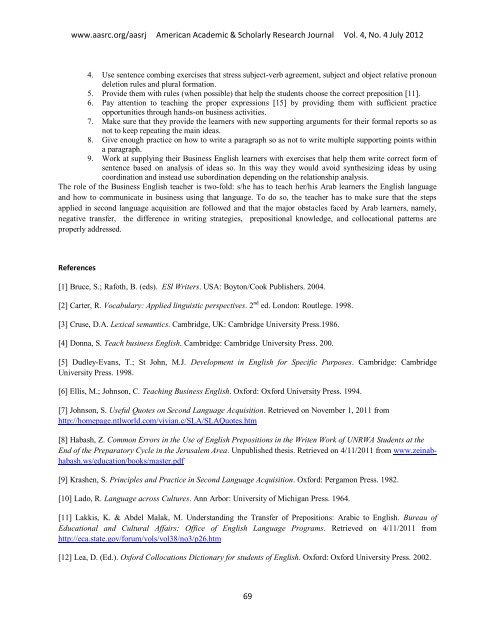E - American Academic & Scholarly Research Center
E - American Academic & Scholarly Research Center
E - American Academic & Scholarly Research Center
You also want an ePaper? Increase the reach of your titles
YUMPU automatically turns print PDFs into web optimized ePapers that Google loves.
www.aasrc.org/aasrj <strong>American</strong> <strong>Academic</strong> & <strong>Scholarly</strong> <strong>Research</strong> Journal Vol. 4, No. 4 July 2012<br />
4. Use sentence combing exercises that stress subject-verb agreement, subject and object relative pronoun<br />
deletion rules and plural formation.<br />
5. Provide them with rules (when possible) that help the students choose the correct preposition [11].<br />
6. Pay attention to teaching the proper expressions [15] by providing them with sufficient practice<br />
opportunities through hands-on business activities.<br />
7. Make sure that they provide the learners with new supporting arguments for their formal reports so as<br />
not to keep repeating the main ideas.<br />
8. Give enough practice on how to write a paragraph so as not to write multiple supporting points within<br />
a paragraph.<br />
9. Work at supplying their Business English learners with exercises that help them write correct form of<br />
sentence based on analysis of ideas so. In this way they would avoid synthesizing ideas by using<br />
coordination and instead use subordination depending on the relationship analysis.<br />
The role of the Business English teacher is two-fold: s/he has to teach her/his Arab learners the English language<br />
and how to communicate in business using that language. To do so, the teacher has to make sure that the steps<br />
applied in second language acquisition are followed and that the major obstacles faced by Arab learners, namely,<br />
negative transfer, the difference in writing strategies, prepositional knowledge, and collocational patterns are<br />
properly addressed.<br />
References<br />
[1] Bruce, S.; Rafoth, B. (eds). ESl Writers. USA: Boyton/Cook Publishers. 2004.<br />
[2] Carter, R. Vocabulary: Applied linguistic perspectives. 2 nd ed. London: Routlege. 1998.<br />
[3] Cruse, D.A. Lexical semantics. Cambridge, UK: Cambridge University Press.1986.<br />
[4] Donna, S. Teach business English. Cambridge: Cambridge University Press. 200.<br />
[5] Dudley-Evans, T.; St John, M.J. Development in English for Specific Purposes. Cambridge: Cambridge<br />
University Press. 1998.<br />
[6] Ellis, M.; Johnson, C. Teaching Business English. Oxford: Oxford University Press. 1994.<br />
[7] Johnson, S. Useful Quotes on Second Language Acquisition. Retrieved on November 1, 2011 from<br />
http://homepage.ntlworld.com/vivian.c/SLA/SLAQuotes.htm<br />
[8] Habash, Z. Common Errors in the Use of English Prepositions in the Writen Work of UNRWA Students at the<br />
End of the Preparatory Cycle in the Jerusalem Area. Unpublished thesis. Retrieved on 4/11/2011 from www.zeinabhabash.ws/education/books/master.pdf<br />
[9] Krashen, S. Principles and Practice in Second Language Acquisition. Oxford: Pergamon Press. 1982.<br />
[10] Lado, R. Language across Cultures. Ann Arbor: University of Michigan Press. 1964.<br />
[11] Lakkis, K. & Abdel Malak, M. Understanding the Transfer of Prepositions: Arabic to English. Bureau of<br />
Educational and Cultural Affairs: Office of English Language Programs. Retrieved on 4/11/2011 from<br />
http://eca.state.gov/forum/vols/vol38/no3/p26.htm<br />
[12] Lea, D. (Ed.). Oxford Collocations Dictionary for students of English. Oxford: Oxford University Press. 2002.<br />
69


